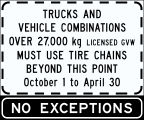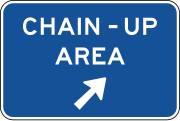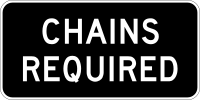Proposal:Snow chains
| Snow chains | |
|---|---|
| Proposal status: | Proposed (under way) |
| Proposed by: | Trapicki |
| Tagging: | snow_chains; snow_chains:conditional; snow_chains:variable; highway=chain_up_area=* |
| Applies to: | way |
| Definition: | Requirements (possibly with conditions and variable) to put snow chains on your vehicle when driving on this highway, with places reserved for putting on snow chains. |
| Draft started: | 2021-11-09 |
| RFC start: | 2021-11-11 |
Statistics
Proposal
Tags related to snow chains:
- Restrictions on roads regarding snow chains
- Areas to put on snow chains (which are dedicated and usually parking restrictions applies
- Vehicle properties "snow_chains" and "winter_tires" for conditional tags
Notes:
- In some countries (e.g. Austria), some vehicles (vehicles > 3.5 t) under certain conditions (always at ice or snow) are required to use snow chains. This legal requirement shall not be tagged with tags from this proposal.
Traffic sign tagging related to snow chains are not part of this proposal, because this would be part of a different aspect with a much wider scope. Still for complentenes these are referred to.
Rationale
In areas where roads are covered in snow and ice during winter, on sufficiently steep roads motorized vehicles may be required to have snow chains (tire chains) attached. On some road sections like tunnels snow chains may be prohibited.
On some roads, special areas are reserved for putting on/laying/ chains / chaining up ("chain-up areas", "chain bays") or removing them, which are reasonable flat, allow rolling the car to facilitate chaining up, and allow to accelerate safely also in heavy snowfall. Most probably these areas will have parking restrictions to ensure that in case they are needed, space is available, and vehicles leave as fast as possible.
Often, the requirement to use snow chains is issued on demand by, indicated by special road signs that can be covered, flipped open/close, turned sideways, unmounted, or are operated from remote electrically. Tagging on-demand restrictions is important to let mappers and users understand that the road sign may be presented different in different conditions. This prevents accidential removal of tags and allows to undertand that an unlegible road sign may be active at some other time of year.
Usually the reqirement for snow chains is conditional, most commonly restricted to conditions of ice or snow, but also certain types of vehicles (e.g. trucks, all wheel drive, weight), directions (e.g. downhill), or vehicle eqipment (e.g. winter tires, "winter equipment"); this may also apply to to on-demand snow chain requirements.
Even though this is quite common in the European Alps and other parts of Europe and the world (During Draft status: Please add your knowledge where snow chains are required by traffic signs in the world!) we do not yet have any tagging sheme for these things. But they are useful for several reasons:
- It's part of everyday life of drivers/law enforcement/fire brigades in significant parts of the world.
- For routing, it is important to know about existing or possible limitations or equipment that may be necessary, which is especially true for snow chains. As snow chains are only necessary and/or required under certain conditions this may change depening on the time one travels the route, it may even change on short notice during the journey. Knowing the possible limitations beforehand allows to adjust the route or equipment accordingly and consider the implications accordingly. Routes could also filter to not require winter equipment. In case snow chains are compulsory, places to put on snow chains (chain-up area, chain bay) may be shown/listed to help travelers.
Tagging
The decission to put on chains is usually understood to be judged by the driver evaluating the road condition; because (metal) snow chains may damage or excessively wear a road, chains should be removed whenever they are not required any more. Please keep in mind that a (conditional) requirement for chaining up may be shown on roads may also be shown when there is actually no snow, ice, snowfall or general winter conditions in the area. Use common sense.
Key snow_chains=*
Applies to highway=whatever applies to motorized vehicles, ways only.
Values:
- snow_chains=required: Snow chains always required (traffic sign symbol: tire with snow chains on blue circle)
- snow_chains=prohibited: Snow chains never allowed, e.g. in tunnels (textual trafic sign, traffic sign symbol unknown)
- snow_chains=carried: Snow chains have to be carried on the vehicle. This does not include the obligation to fit them immediately, this would have to be announced by a separate snow_chains=required (textual trafic sign).
- snow_chains=recommended: Snow chains are recommended to be put on. This does not include the obligation to fit them or carry them on the vehicle. (textual trafic sign, e.g. USA, Idaho W 8-1301 [1] [2])
- snow_chains=default: Only with snow_chains:conditional=* to express that no general requirement is active, and because Conditional restrictions#Default restrictions requires a non-conditinal value.
In most cases (at least in Central Europe), snow chains will be required conditionally (fixed rule, additional traffic signs) and/or on demand (issued by local authorities depending on the actual situation).
Subkey snow_chains:conditional=*
Standard Conditional restrictions. Use separate snow_chains=*
Examples of values:
- snow_chains:conditional=yes @ snow; yes @ ice: Very common, may be indicated by additional snowflake sign. Note: syntax for conditional has no "OR", this multiple conditions have to be stated separa
- snow_chains:conditional=no @ motorcar AND winter_tires: Snow chains required, expect for motorcars (Class N) with winter tires.
Conditional vehicle properties "snow_chains" and "winter_tires"
For Conditional restrictions, explicitly list "snow_chains" and "winter_tires". This allows for better conditional restrictions and exceptions, both directly with snow_chains=* and other tags.
Subkey snow_chains:variable=*
Values:
- snow_chains:variable=weather - Snow chains required as announced on site, on weather dependent decission of road authorities.
- snow_chains:variable=no Traffic sign is known to be permanent. If it is not determined if the restriction is variable or not, do not set this value.
Can be combined with snow_chains:conditional=*: A restricion may be both conditional (e.g. specific type of vehicle) but only shown at specific weather conditions.
Subkey snow_chains:variable:type=*
Encodes the way how this sign is variable. Usefull to tell users and mappers what to look for in case it's active but also in case it's inactive.
Sign may be flippable, foldable, turnable, coverable, removable, remote controlled electrically, flashing when active, rolling banner, etc..
- snow_chains:variable:type=turnable: Sign might be turned sideways, front of the sign probly facing away from the road.
- snow_chains:variable:type=foldable: Sign might be folded up or down, front of the sign probly facing towards upcomming trafic, but blank.
- snow_chains:variable:type=coverable: Sign might be covered in cloth or with a plate, front of the sign facing towards upcomming trafic.
- snow_chains:variable:type=removable: Sign or parts of it might be removed, leaving only a sign post with mounting brackets or similar.
- snow_chains:variable:type=flashing: Sign has flashlights and text stating that it is active when flashlights are blinking. Still visible if not active.
- snow_chains:variable:type=prism: Sign consist of rotable prisms that show three or four different variants. May be blank or showing different information if not active.
- snow_chains:variable:type=display: LED matrix display, may show anything; LED display with possibly multiple predefefined signs; both may be blank or shof different information if not active. Please only map restrictions that are known to be displayed on a regular basis
- snow_chains:variable:type=rolling_banner: Rolling banner display. May be blank or showing different information if not active.
Related tags:
Notes:
- crossing:on_demand=* is similar, but not the same; it is more leaning towards "on request" then "if the situation requires it". snow_chains:on_demand=* is a subkey, and does not collide with crossing:on_demand=*
- maxspeed:variable=* was my first though, but "variable" is usually used to indicate a restriction (speed limit) that always applies and is changed depending on conditions, and moreover "on demand" is more self-explaining, and easier to understand and remember.
Value highway=chain_up_area
For areas that are primarily dedicate to putting on/off snow chains. No distinction is made for areas intended to specifically chain-down/put off chains.
Related to highway=rest_area and highway=emergency_bay, but with a different purpose:
| Chain-up area | Chain bay | Rest area | Emergency bay | |
|---|---|---|---|---|
| Purpose | chaining up | chaining up | resting, staying, refreshing, parking | stop at emergency |
| Parking, extended stay? | very probably not | no | yes | no |
| Chaining up possible | yes | yes | yes | yes |
| All year open? | no, only winter | no, only winter. Maybe emergency bay all year. | all year | yes |
| Expected amenities | optional: lighting | optional: lighting, emergency phone | parking area, toiletts, picnick tables, waste baskets, lighting | optional: lighting, emergency phone |
| Separation from main road | yes | no | yes | no |
| Tagged as | area | way or point | area or point | way or point |
A rest area may be used to chain up, but a chain-up area may not be used as rest area.
- If separated from main road: Area tagged with highway=chain_up_area Roads tagged as highway=service. May be combined with parking:lane:both=no_parking (no parking, halting ok), parking:lane:both=no (no parking, no halting) etc. Restrictions (parking) should go with the road, not the area!
- If at the shoulder
- Apropriate for many vehicles (maybe hundreds of meters long): Way tagged with highway=chain_up_area
- For few or just one vehicle: A simple node highway=emergency_bay style may be appropriate.
name=* should be set only if known, as name=chain-up area [known name]. Reason: The areas may get named after a near known place, while not being that very place itself. name=chain-up area is wrong by Good practice: Don't use name tag to describe things
If numbered/coded, ref=* should be set and rendered. For example in Australia, highest elevated chain area for a pass has ref=1, counting up descending from that one.
Note: This key could subsume Proposed features/amenity=chain bay. Differing to that proposal, I'd rather not call it "bay", because there exist ones that are more separated from the main road.
Related tags
incline=*
Examples
| Tagging | Explanation | Note | Image |
|---|---|---|---|
| Snow chains required when road is covered in snow or ice. |
|
||
|
Snow chains required when road is covered in snow or ice, but not for uphill driving AWD motor vehicles. |
|
|
|
Snow chains required, except for motorcars (Class N) with winter tires. | ||
|
Sign can be rotated. When turned to face to approaching traffic: Snow chains required, except for motorcars (Class N) with winter tires. | ||
| Named chain-up area | Dedicated chaining up/down, not a highway=rest_area | Note: image missing |
Vienna Convention:
snow_chains=requiredCanada (British Columbia):
snow_chains:hgv:conditional=required @ (Oct 1 - Apr 30 AND weight > 27000 kg)United States:
highway=chain_up_areaUnited States (California):
snow_chains=requiredAustria, Pötschenpass
snow_chains:conditional=required @ (ice AND weight>3.5); required @ (snow AND weight>3.5)
Rendering
Road
For winter theme, add some bold/colored/dashed(for "on_demand") highlighting.
Chain-up area
Like resting area, but cooler color (light violet) and with snow chain as symbol. Can occur alongside parking sign, if parking is allowed and tagged.
Features/Pages affected
Related Topics
Informal listing for reference only, not part of the proposal.
snowplowing=*- mountain_pass=*
Proposed features/amenity=chain baycanceled- Proposed features/Snow removal station
- Proposed features/Extended traffic signs tagging
Candidates
- Austria
- B179 Fernpassstraße near Biberwier https://www.openstreetmap.org/node/3247772931
- B99 Katschbergstraße near Niedertauern Anlegeplatz (chain-up) https://www.openstreetmap.org/node/3247772931 Ablegeplatz (chain-down) https://www.openstreetmap.org/way/543640239
- B173 Eibergbundesstraße near Eiberg Articles: https://www.tt.com/artikel/12387597/kettenanlegeplatz-soll-winterchaos-verhindern https://www.tirol.gv.at/verkehr/baubezirksaemter/bba-kufstein/strassenbau/bau-strasse/archiv/kettenanlegeplatz-eiberg/ maybe https://www.openstreetmap.org/way/365879239 https://www.mapillary.com/app/?pKey=498512804607926
- S16 Arlberg Schnellestraße: Kettenanlegeplatz Bings https://www.openstreetmap.org/way/507523309 Snow chains compulsory in Austria for vehicles > 3.5 t always at ice or snow. All primary roads (Autobahn, Schnellstraße) have chain up areas where there is usually need in case of snow fall. TODO: get list/locations from ASFINAG.
- Germany
- OA9 Riedbergstraße near Obermaiselstein https://www.openstreetmap.org/way/305030048
- US
- Canada
Road signs
- Canada
- British Columbia: https://www.tranbc.ca/2011/02/03/do-i-need-to-chain-up-yes-and-maybe/
- Wikipedia Commons: https://commons.wikimedia.org/wiki/Category:Snow_chains-related_road_signs?uselang=de
- In Austria[2][1], Germany, Italy, Switzerland, Czeck Republic and other countries a traffic sign for "snow chains required" exists and is in common use.
- The UN Vienna Convention on Road Signs and Signals[3] defines
- a snow chain sign as D, 9 "SNOW CHAINS COMPULSORY" and E, 21 / E, 22 "CHAINS OR SNOW TYRES RECOMMENDED".
- Annex 5 F.7. "ROAD OPEN OR CLOSED" sign: Sign E, 21, "ROAD OPEN OR CLOSED", shall be used to show whether a mountain road, particularly a section leading over a pass, is open or closed; the sign shall be placed at the entry to the road or roads leading to the section in question. The name of the section of road (or pass) shall be inscribed in white. On the sign shown, the name "Furka" is given as an example. Panels 1, 2 and 3 shall be removable. If the section of road is closed, panel 1 shall be red and shall bear the inscription "CLOSED1 ; if the section is open, panel 1 shall be green and shall bear the inscription "OPEN", The inscriptions shall be in white and preferably in several languages. Panels 2 and 3 shall have a white ground with inscriptions and symbols in black. If the section of road is open, panel 3 shall remain blank and panel 2, according to the state of the road, shall either be blank, or display sign D, 9, "SNOW CHAINS COMPULSORY", or display symbol E, 22, "CHAINS OR SNOW TYRES RECOMMENDED". This symbol shall be black. If the section of road is closed, panel 3 shall show the name of the place up to which the road is open and panel 2 shall display, according to the state of the road, either the inscription "OPEN AS FAR AS", or symbol E, 22, or sign D, 9.One "Road Open or Closed" sign, for the "Furka" example in the Convention, is located at 500 m west of Hospental, CH. A similar sign for the three passes Furka, Grimsel and Gletch is located just north of Oberwald, CH. Road directions with "Road Open or Closed" style information can be found just south of Ulrichen, CH.
Legal requirements
By Good practice: Don't map your local legislation, if not bound to objects in reality this proposal is not concerned with regional or national regulations. Nevertheless it is important to interpret the actual road signage in context of the legal regulations.
Pages like
could be created. A very good start would be https://de.wikipedia.org/wiki/Winterausrüstung_(Straßenverkehr) which is unfortunately German only.
External discussions
- Mailinglist [Talk-at] Mappen von Schneekettenpflicht 2019-11-09 German
- Forum users: German: Durchfahrt verboten/ohne Winterausrüstung
- Note 47436 Leberstraße
- How to tag access restriction on snow and ice on help.openstreetmap.org
- How to tag mountain_pass seasonal openings? on help.openstreetmap.org
Version/Changes
| Version | Change | Discussion Topics |
|---|---|---|
| 0 | Last Draft | |
| 1 |
|
|
| 2 |
|
|
| 3 |
|
Comments
Please comment on the discussion page.
General References
- ↑ 1.0 1.1 | StVO §54 Z. 5 lit. f "Diese Zusatztafel weist darauf hin, dass das Straßenverkehrszeichen bei Schneelage oder Eisbildung auf der Fahrbahn zu beachten ist." in RIS
- ↑ | StVO §51 lit. b Nr. 22 Gebotszeichen "SCHNEEKETTEN VORGESCHRIEBEN" in RIS
- ↑ https://treaties.un.org/Pages/ViewDetailsIII.aspx?src=TREATY&mtdsg_no=XI-B-20&chapter=11&Temp=mtdsg3&clang=_en










